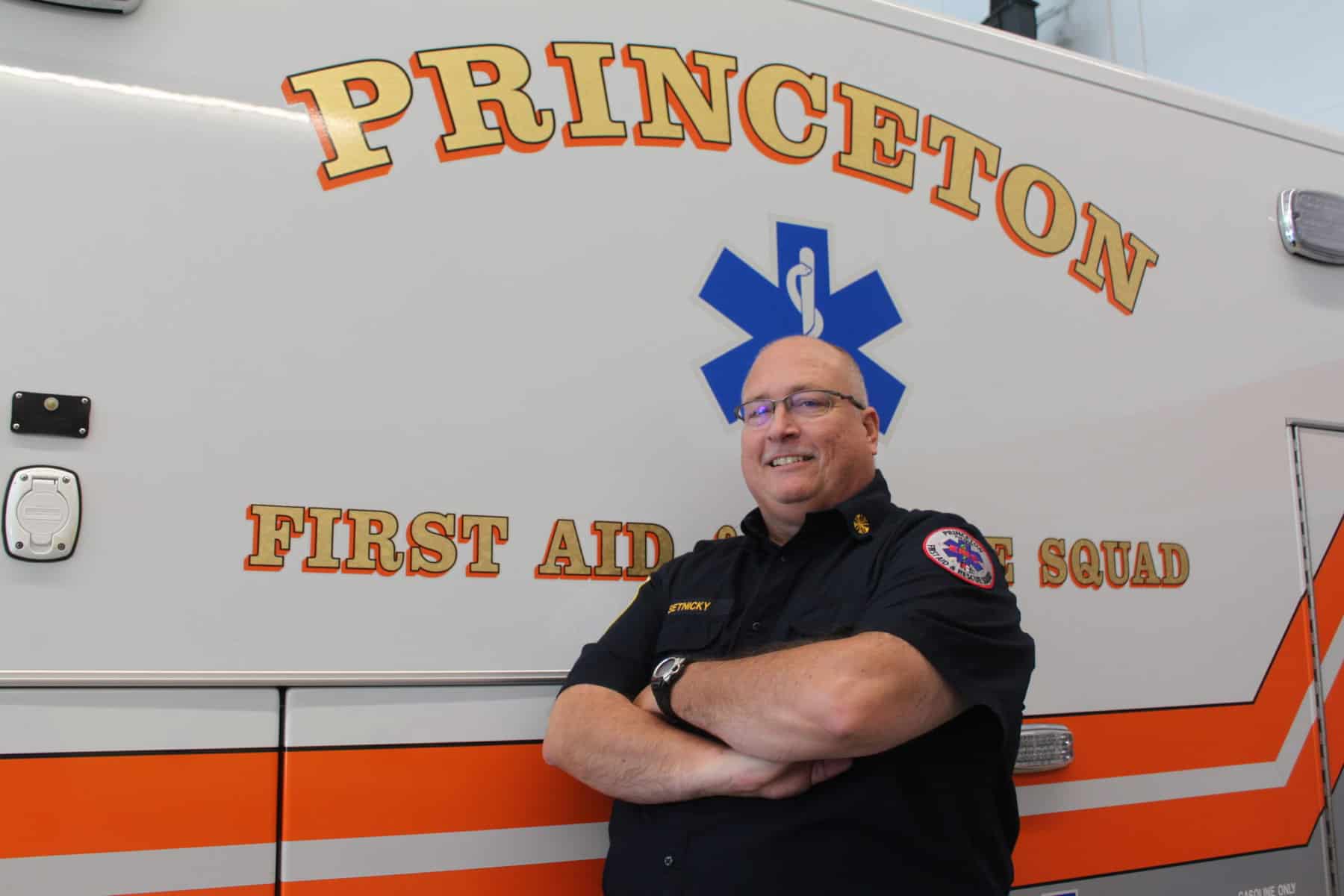Hanging in the window in Frank Setnicky’s office at the Princeton First Aid and Rescue Squad, there is a colorful set of interlocking rings on a construction paper chain.
Setnicky calls it his retirement ring. It gets shorter and shorter every day as he pulls a ring off the paper chain – and by Oct. 20, there won’t be one ring left on it.
That’s because Setnicky officially retires at noon – not that he’s counting the days.
Setnicky is capping off a 35-year career as an emergency medical technician at the Princeton First Aid and Rescue Squad, rising through the ranks to become its first chief, or operations director, in 2007.
“I really do enjoy the job, (but) I am looking forward to retirement. I am fortunate to be able to retire at a young age,” said the 57-year-old Setnicky.
Setnicky, who grew up in Ringoes in Hunterdon County, was introduced to the world of emergency medical services as a teenager. His initial contact was the result of a broken leg as a 13-year-old. He was impressed with the first responders.
“They came and took care of me. I thought it would something interesting to do,” Setnicky said.
Setnicky joined the Amwell Valley Ambulance Corps, which provides emergency medical services to residents in Ringoes and the surrounding area. He became a certified EMT at 16 years old – the first year that state officials allowed 16-year-olds to take the course. The minimum age had been 18 years old.
Setnicky volunteered with the ambulance corps while he was in high school. Upon graduation, he took a job in a factory but decided “this is not the place that I wanted to stay in for a long time.”
Setnicky was reading through some job advertisements and learned that the Princeton First Aid and Rescue Squad needed a full-time EMT.
“I loved doing emergency medical services, so I said, ‘I’ll give it a shot,’ ” he said.
Setnicky was hired as an EMT in 1986, and was named its operations director in 2007. He is one of a handful of paid employees. The squad also includes volunteer EMTs, in addition to the paid EMTs.
While Setnicky has responded to thousands of calls in his career, there is one that stands out. It was a call for a cardiac arrest – a routine call for the squad – but it was the first time that the EMTs had used an automated external defibrillator, or AED. It stimulates the heart through electric shocks.
“The man had passed out and he was lying on the sidewalk on Palmer Square. When we got there, he was in cardiac arrest. He was dead. He was not breathing and he did not have a pulse,” Setnicky said.
The EMTs started cardiopulmonary resuscitation and then they used the AED, which brought him back to life. He regained consciousness in the ambulance on the way to the hospital, Setnicky said. The man walked out of the hospital a few days later.
That incident marked the first time that the Princeton First Aid and Rescue Squad had used the AED, right after the state allowed for its use, he said. It was the first or second first aid squad in New Jersey to use it to save someone, he said.
“Bad things happen to people. It’s just a fact, a lot of cardiac arrest (victims) do not pull through with just CPR. It’s important to use the defibrillator,” Setnicky said.
“To this day, that call was pretty cool. The man was dead in front of you, and we brought him back from the dead,” Setnicky said.
Another memorable call was the first baby that he helped to deliver. It was a cold day in January 1987, a few months after he was hired as an EMT. The EMT crew went into the house, just as the baby was about to be born.
“It was awesome. How many times we go to a call that is negative – a bad medical situation – when life is leaving a person, and here we are, bringing a life into the world,” Setnicky said.
“It’s like a bookend – a life is leaving the world and a life is entering the world. The baby was a good outcome,” he said.
While technical skills are needed – it takes 190 hours of study to become a certified EMT – so are soft skills, he said. To be an EMT requires being a “people person” and to be able to relate to the patient, he said.
“You have to be able to speak to the person and get out of your own comfort zone. From a patient’s perspective, you want someone to come in and say, ‘This is what’s going on and this what we are going to do.’ You have to instill confidence in the person, who is not having a good day,” Setnicky said.
“Nobody really plans to have us, but when they are in need, they are glad to see us. We see people on their worst day. It takes a lot for them to call us. They want to be independent.
“But if you don’t feel right, call us. We are waiting to help,” Setnicky said.
Asked why he stayed on as a paid EMT, Setnicky replied that it’s just “the drive to help. I liked teaching the new members that came in. I look back at the number of people who have come through here and who have gone into the medical and health professions. It’s a good experience.
“I loved being an EMT, and I liked coming to my job. I liked being able to help out.
“I would do it all over again,” Setnicky said.

